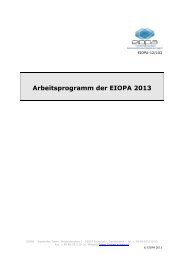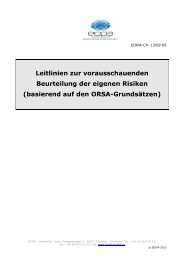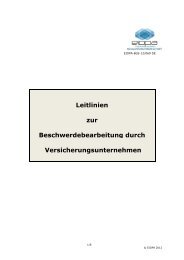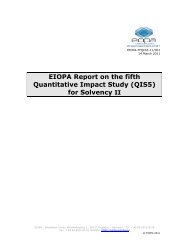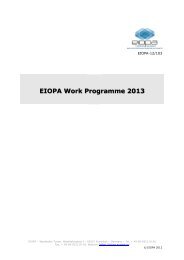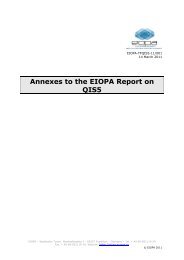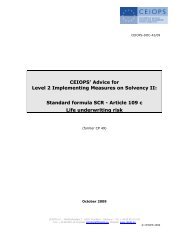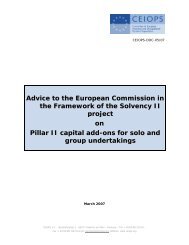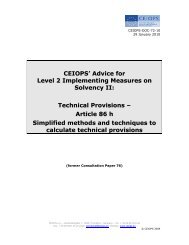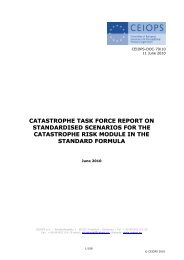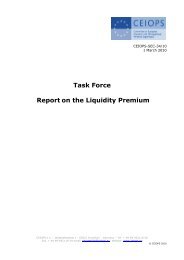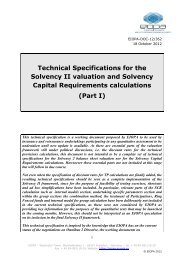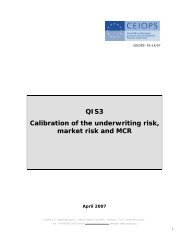Answers to the European Commission on the ... - Eiopa - Europa
Answers to the European Commission on the ... - Eiopa - Europa
Answers to the European Commission on the ... - Eiopa - Europa
Create successful ePaper yourself
Turn your PDF publications into a flip-book with our unique Google optimized e-Paper software.
<strong>on</strong> <str<strong>on</strong>g>the</str<strong>on</strong>g> 'fatness' of <str<strong>on</strong>g>the</str<strong>on</strong>g> tail of <str<strong>on</strong>g>the</str<strong>on</strong>g> distributi<strong>on</strong> functi<strong>on</strong> for <str<strong>on</strong>g>the</str<strong>on</strong>g> <str<strong>on</strong>g>to</str<strong>on</strong>g>tal claim<br />
amounts.<br />
E.24 With respect <str<strong>on</strong>g>to</str<strong>on</strong>g> both approaches sketched above it should be noticed<br />
that <str<strong>on</strong>g>the</str<strong>on</strong>g> analysis of <str<strong>on</strong>g>the</str<strong>on</strong>g> impact of a given reinsurance arrangement<br />
(c<strong>on</strong>sisting of both proporti<strong>on</strong>al and n<strong>on</strong>-proporti<strong>on</strong>al covers) <strong>on</strong> <str<strong>on</strong>g>the</str<strong>on</strong>g><br />
tail behaviour of <str<strong>on</strong>g>the</str<strong>on</strong>g> distributi<strong>on</strong> functi<strong>on</strong> of <str<strong>on</strong>g>the</str<strong>on</strong>g> <str<strong>on</strong>g>to</str<strong>on</strong>g>tal claim amount –<br />
and accordingly <strong>on</strong> <str<strong>on</strong>g>the</str<strong>on</strong>g> volatility of <str<strong>on</strong>g>the</str<strong>on</strong>g> underwriting result – is a<br />
complex issue. In order <str<strong>on</strong>g>to</str<strong>on</strong>g> find an answer <str<strong>on</strong>g>to</str<strong>on</strong>g> <str<strong>on</strong>g>the</str<strong>on</strong>g> questi<strong>on</strong> <strong>on</strong> how such<br />
complex reinsurance arrangements should impact <strong>on</strong> <str<strong>on</strong>g>the</str<strong>on</strong>g> capital charge<br />
related <str<strong>on</strong>g>to</str<strong>on</strong>g> <str<strong>on</strong>g>the</str<strong>on</strong>g> underwriting risk, it seems necessary <str<strong>on</strong>g>to</str<strong>on</strong>g> turn <str<strong>on</strong>g>to</str<strong>on</strong>g><br />
approximate methods and simulati<strong>on</strong> techniques.<br />
E.25 However, it should in any case be stressed that n<strong>on</strong>-proporti<strong>on</strong>al<br />
reinsurance covers are in general more 'efficient' than proporti<strong>on</strong>al<br />
reinsurance covers with respect <str<strong>on</strong>g>to</str<strong>on</strong>g> reducing <str<strong>on</strong>g>the</str<strong>on</strong>g> 'fatness' of <str<strong>on</strong>g>the</str<strong>on</strong>g> tail of<br />
<str<strong>on</strong>g>the</str<strong>on</strong>g> distributi<strong>on</strong> functi<strong>on</strong> (of both individual and <str<strong>on</strong>g>to</str<strong>on</strong>g>tal claim amounts)<br />
and accordingly <str<strong>on</strong>g>the</str<strong>on</strong>g> volatility of <str<strong>on</strong>g>the</str<strong>on</strong>g> underwriting result. In <str<strong>on</strong>g>the</str<strong>on</strong>g> IAA<br />
Solvency Report this aspect is briefly summarised as follows:<br />
“[r]einsurance, in particular <str<strong>on</strong>g>the</str<strong>on</strong>g> n<strong>on</strong>-proporti<strong>on</strong>al type, can greatly<br />
reduce, or even eliminate, <str<strong>on</strong>g>the</str<strong>on</strong>g> extreme tail of <str<strong>on</strong>g>the</str<strong>on</strong>g> cedant’s loss<br />
distributi<strong>on</strong>. This effect can be assessed ma<str<strong>on</strong>g>the</str<strong>on</strong>g>matically if <str<strong>on</strong>g>the</str<strong>on</strong>g> TVar risk<br />
measure is being used. […] If applied properly in a solvency or<br />
management c<strong>on</strong>text, reinsurance is a very efficient means of reducing<br />
risk (particularly if measured by TVar) and <str<strong>on</strong>g>the</str<strong>on</strong>g>refore risk-bearing<br />
capital.”<br />
E.26 This aspect should be taken in<str<strong>on</strong>g>to</str<strong>on</strong>g> account when stipulating <str<strong>on</strong>g>the</str<strong>on</strong>g> part of<br />
<str<strong>on</strong>g>the</str<strong>on</strong>g> SCR representing <str<strong>on</strong>g>the</str<strong>on</strong>g> capital charge for underwriting risk, cf. also<br />
<str<strong>on</strong>g>the</str<strong>on</strong>g> last secti<strong>on</strong> of <str<strong>on</strong>g>the</str<strong>on</strong>g> present part.<br />
Correlati<strong>on</strong> effects<br />
E.27 The main purpose of this secti<strong>on</strong> is <str<strong>on</strong>g>to</str<strong>on</strong>g> discuss <str<strong>on</strong>g>the</str<strong>on</strong>g> possible impact of<br />
various reinsurance covers <strong>on</strong> <str<strong>on</strong>g>the</str<strong>on</strong>g> tail correlati<strong>on</strong> or tail dependence<br />
between two or several lines of business (LOBs).<br />
E.28 In general terms it may be stated that 'tail correlati<strong>on</strong>' or 'tail<br />
dependence' occurs if two or more LOBs apparently operate<br />
independently in 'normal times' but deteriorate <str<strong>on</strong>g>to</str<strong>on</strong>g>ge<str<strong>on</strong>g>the</str<strong>on</strong>g>r if <str<strong>on</strong>g>the</str<strong>on</strong>g><br />
'insurance envir<strong>on</strong>ment' (in some sense) deteriorates. A more precise<br />
explanati<strong>on</strong> may be <str<strong>on</strong>g>to</str<strong>on</strong>g> describe tail dependence as “<str<strong>on</strong>g>the</str<strong>on</strong>g> phenomen<strong>on</strong><br />
whereby certain loss distributi<strong>on</strong>s show dependence <strong>on</strong>ly in <str<strong>on</strong>g>the</str<strong>on</strong>g><br />
extreme tail.” 161 In <str<strong>on</strong>g>the</str<strong>on</strong>g> presence of this phenomen<strong>on</strong> it should be<br />
noticed that standard correlati<strong>on</strong> analysis will not be able <str<strong>on</strong>g>to</str<strong>on</strong>g> capture<br />
“<str<strong>on</strong>g>the</str<strong>on</strong>g> fact that certain areas of <str<strong>on</strong>g>the</str<strong>on</strong>g> loss distributi<strong>on</strong>s may be highly<br />
correlated while o<str<strong>on</strong>g>the</str<strong>on</strong>g>rs are less correlated or independent.”<br />
161 Cf. Seamus Creed<strong>on</strong> et. al (2003): ”Risk and Capital Assessment and Supervisi<strong>on</strong> in Financial Firms”,<br />
Working Report presented <str<strong>on</strong>g>to</str<strong>on</strong>g> <str<strong>on</strong>g>the</str<strong>on</strong>g> GIRO C<strong>on</strong>venti<strong>on</strong> 2003.<br />
276



